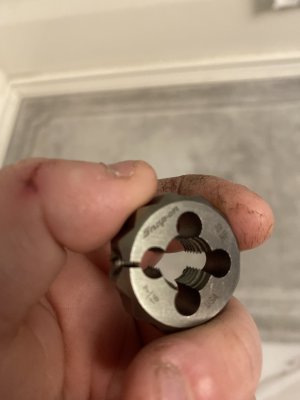-
Welcome back Guest! Did you know you can mentor other members here at H-M? If not, please check out our Relaunch of Hobby Machinist Mentoring Program!
You are using an out of date browser. It may not display this or other websites correctly.
You should upgrade or use an alternative browser.
You should upgrade or use an alternative browser.
Threading dies
- Thread starter Brento
- Start date
- Joined
- Apr 14, 2014
- Messages
- 3,534
The adjustable die is used to make different thread tolerances. Thread tolerances are expressed in "H" limits. A thread made to the exact size of the nominal size is an H0 (as in zero). Each .0005" over the nominal size is one H size larger. For an example a 3/8-16 H1 thread is .0005 larger than the .375" nominal size, an H2 thread is .001" larger, and an H3 thread is .0015 larger" If I recall correctly H limits go up to H12. Those over H4 or H5 are usually used when threads are cut then the part is plated.I have a Snap on die that has an adjustable screw. Now iirc dies with an adjustable screw. Usually are cutting the threads and not chasing correct? I also have a die downstairs that is a round die from Dunlap and also wondering if that would be a cutting die or chasing.
The adjusting screw allows the die to be enlarged to meet the H limit required. The most common for fractional sizes is H3. Smaller number sizes are usually H1 or H2.
As for hex dies being for rethreading and round dies being for thread cutting that is a general rule, but not necessarily a hard and fast rule. I have hex dies that are thread cutting dies. They're generally used in tight places with a socket and extension where a standard die wrench would be difficult or impossible to use.
I have a full set of Snap On "triple hex dies" like this:

Snap-On 1/2" -20NF Die SH Hex Hexagon Tool Compare Blue Point GA5411220 | eBay
Find many great new & used options and get the best deals for Snap-On 1/2" -20NF Die SH Hex Hexagon Tool Compare Blue Point GA5411220 at the best online prices at eBay! Free shipping for many products!
www.ebay.com
They are thread cutting dies that can be used in either a die wrench or socket.
Those are the exact same dies i have that i am talking about.The adjustable die is used to make different thread tolerances. Thread tolerances are expressed in "H" limits. A thread made to the exact size of the nominal size is an H0 (as in zero). Each .0005" over the nominal size is one H size larger. For an example a 3/8-16 H1 thread is .0005 larger than the .375" nominal size, an H2 thread is .001" larger, and an H3 thread is .0015 larger" If I recall correctly H limits go up to H12. Those over H4 or H5 are usually used when threads are cut then the part is plated.
The adjusting screw allows the die to be enlarged to meet the H limit required. The most common for fractional sizes is H3. Smaller number sizes are usually H1 or H2.
As for hex dies being for rethreading and round dies being for thread cutting that is a general rule, but not necessarily a hard and fast rule. I have hex dies that are thread cutting dies. They're generally used in tight places with a socket and extension where a standard die wrench would be difficult or impossible to use.
I have a full set of Snap On "triple hex dies" like this:

Snap-On 1/2" -20NF Die SH Hex Hexagon Tool Compare Blue Point GA5411220 | eBay
Find many great new & used options and get the best deals for Snap-On 1/2" -20NF Die SH Hex Hexagon Tool Compare Blue Point GA5411220 at the best online prices at eBay! Free shipping for many products!www.ebay.com
They are thread cutting dies that can be used in either a die wrench or socket.
Where did you get the 30%?Please be aware that using a thread cutting die to clean up rolled threads (i.e. bolts) will cut the root out of the thread thus reducing the bolts capacity by about 30%.

